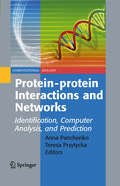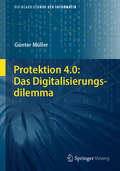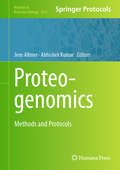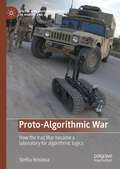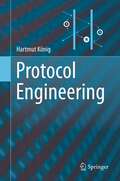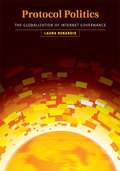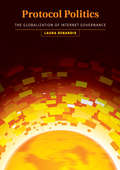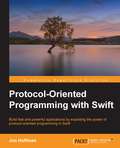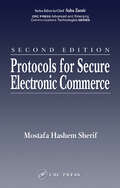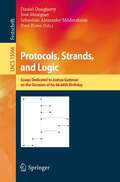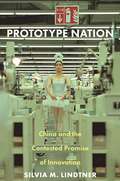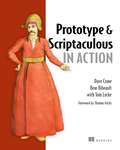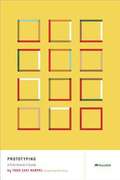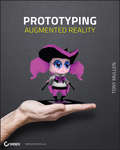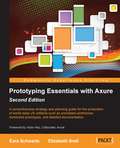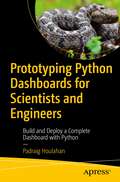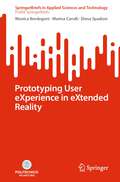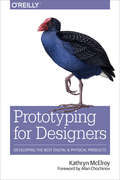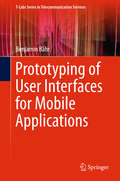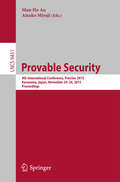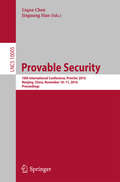- Table View
- List View
Protein-protein Interactions and Networks
by Anna Panchenko Teresa M. PrzytyckaThe biological interactions of living organisms, and protein-protein interactions in particular, are astonishingly diverse. This comprehensive book provides a broad, thorough and multidisciplinary coverage of its field. It integrates different approaches from bioinformatics, biochemistry, computational analysis and systems biology to offer the reader a comprehensive global view of the diverse data on protein-protein interactions and protein interaction networks.
Protektion 4.0: Das Digitalisierungsdilemma (Die blaue Stunde der Informatik)
by Günter MüllerDas Buch beschreibt Datenschutz erstmals als Offenheit (Transparenz) statt Datensparsamkeit. Der Autor beschreibt als Voraussetzung dazu einen Besitztitel auf Daten. Die Umsetzung erfolgt über Big Data, deren Techniken so ausgelegt sind, dass Daten zur „handelbaren“ Ware werden können, indem dokumentierbar wird, wie von wem wozu Daten verwendet worden sind. Transparente Verwendung auch in Hinsicht auf den Nutzen oder die Notwendigkeit statt Verbergen wird als neues Privatheitsmodell vorgeschlagen. Die Synchronisation der Entwicklung von Technik und Gesellschaft steht dabei im Vordergrund. Zahlreiche Fallstudien erhöhen den praktischen Nutzen des Buches.
Proteogenomics: Methods and Protocols (Methods in Molecular Biology #2859)
by Jens Allmer Abhishek KumarThis volume presents an up-to-date overview of the current state-of-the-art protocols, and aims to put proteogenomics into a broader perspective. The chapters in this book detail methods and techniques ranging from mass spectrometry to proteomics and proteogenomics and their biomedical implications and applications. Written in the highly successful Methods in Molecular Biology series format, the chapters include introductions to their respective topics, application details for both the expert and non-expert reader, and tips on troubleshooting and avoiding known pitfalls. A highlight for everyone new to the field are the chapters, which put proteogenomics to use to answer biomedical questions. Authoritative and accessible, Proteogenomics: Methods and Protocols aims to ensure successful results in the further study of this vital field.
Protest Public Relations: Communicating dissent and activism (Routledge New Directions in PR & Communication Research)
by Ana AdiGlobal movements and protests from the Arab Spring to the Occupy Movement have been attributed to growing access to social media, while without it, local causes like #bringbackourgirls and the ice bucket challenge may have otherwise remained unheard and unseen. Regardless of their nature – advocacy, activism, protest or dissent – and beyond the technological ability of digital and social media to connect support, these major events have all been the results of excellent communication and public relations. But PR remains seen only as the defender of corporate and capitalist interests, and therefore resistant to outside voices such as activists, NGOs, union members, protesters and whistle-blowers. Drawing on contributions from around the world to examine the concepts and practice of "activist," "protest" and "dissent" public relations, this book challenges this view. Using a range of international examples, it explores the changing nature of protest and its relationship with PR and provides a radical analysis of the communication strategies and tactics of social movements and activist groups and their campaigns. This thought-provoking collection will be of interest to researchers and advanced students of public relations, strategic communication, political science, politics, journalism, marketing, and advertising, and also to PR professionals in think tanks and NGOs.
Proto-Algorithmic War: How the Iraq War became a laboratory for algorithmic logics (Social and Cultural Studies of Robots and AI)
by Stefka HristovaDuring the Iraq War, American soldiers were sent to both fight an enemy and to recover a “failed state” in pixelated camouflage uniforms, accompanied by robots, and armed with satellite maps and biometric hand-held scanners. The Iraq War, however, was no digital game: massive-scale physical death and destruction counter the vision of a clean replayable war. The military policy of the United States, and not the actual experience of war, has been rooted in the logic of digital, and nascent algorithmic technology. This logic attempted to reduce culture, society, as well as the physical body and environment into visual data that lacks cultural and historical context. This book details the emergence of a nascent algorithmic war culture in the context of the Iraq War (2003-2010) in relation to the data-driven early 20th century British Mandate for Iraq. Through a series of five inquiries into the ways in which the Iraq War attempted to and often failed to see population and territory as digital and further proto-algorithmic entities, it offers an insight into the digitization and further unmanned automaton of war. It does so through a comparative historical framework reaching back to the quantification techniques harnessed during the British Mandate for Iraq (1918-1932) in order to explicate the parallels and complicated the diversions between the numerical logics that have driven both military state-building enterprises.
Protocol Engineering
by Hartmut KönigCommunication protocols form the operational basis of computer networks and telecommunication systems. They are behavior conventions that describe how communication systems interact with each other, defining the temporal order of the interactions and the formats of the data units exchanged - essentially they determine the efficiency and reliability of computer networks. Protocol Engineering is an important discipline covering the design, validation, and implementation of communication protocols. Part I of this book is devoted to the fundamentals of communication protocols, describing their working principles and implicitly also those of computer networks. The author introduces the concepts of service, protocol, layer, and layered architecture, and introduces the main elements required in the description of protocols using a model language. He then presents the most important protocol functions. Part II deals with the description of communication protocols, offering an overview of the various formal methods, the essence of Protocol Engineering. The author introduces the fundamental description methods, such as finite state machines, Petri nets, process calculi, and temporal logics, that are in part used as semantic models for formal description techniques. He then introduces one representative technique for each of the main description approaches, among others SDL and LOTOS, and surveys the use of UML for describing protocols. Part III covers the protocol life cycle and the most important development stages, presenting the reader with approaches for systematic protocol design, with various verification methods, with the main implementation techniques, and with strategies for their testing, in particular with conformance and interoperability tests, and the test description language TTCN. The author uses the simple data transfer example protocol XDT (eXample Data Transfer) throughout the book as a reference protocol to exemplify the various description techniques and to demonstrate important validation and implementation approaches. The book is an introduction to communication protocols and their development for undergraduate and graduate students of computer science and communication technology, and it is also a suitable reference for engineers and programmers. Most chapters contain exercises, and the author's accompanying website provides further online material including a complete formal description of the XDT protocol and an animated simulation visualizing its behavior.
Protocol Politics
by Laura DenardisThe Internet has reached a critical point. The world is running out of Internet addresses. There is a finite supply of approximately 4.3 billion Internet Protocol (IP) addresses--the unique binary numbers required for every exchange of information over the Internet--within the Internet's prevailing technical architecture (IPv4). In the 1990s the Internet standards community identified the potential depletion of these addresses as a crucial design concern and selected a new protocol (IPv6) that would expand the number of Internet addresses exponentially--to 340 undecillion addresses. Despite a decade of predictions about imminent global conversion, IPv6 adoption has barely begun. IPv6 is not backward compatible with IPv4, and the ultimate success of IPv6 depends on a critical mass of IPv6 deployment, even among users who don't need it, or on technical workarounds that could in turn create a new set of concerns. Protocol Politics examines what's at stake politically, economically, and technically in the selection and adoption of a new Internet protocol. Laura DeNardis's key insight is that protocols are political. IPv6 serves as a case study for how protocols more generally are intertwined with socioeconomic and political order. IPv6 intersects with provocative topics including Internet civil liberties, U.S. military objectives, globalization, institutional power struggles, and the promise of global democratic freedoms. DeNardis offers recommendations for Internet standards governance based not only on technical concerns but on principles of openness and transparency and examines the global implications of looming Internet address scarcity versus the slow deployment of the new protocol designed to solve this problem.
Protocol Politics: The Globalization of Internet Governance (Information Revolution and Global Politics)
by Laura DenardisWhat are the global implications of the looming shortage of Internet addresses and the slow deployment of the new IPv6 protocol designed to solve this problem?The Internet has reached a critical point. The world is running out of Internet addresses. There is a finite supply of approximately 4.3 billion Internet Protocol (IP) addresses—the unique binary numbers required for every exchange of information over the Internet—within the Internet's prevailing technical architecture (IPv4). In the 1990s the Internet standards community selected a new protocol (IPv6) that would expand the number of Internet addresses exponentially—to 340 undecillion addresses. Despite a decade of predictions about imminent global conversion, IPv6 adoption has barely begun. Protocol Politics examines what's at stake politically, economically, and technically in the selection and adoption of a new Internet protocol. Laura DeNardis's key insight is that protocols are political. IPv6 intersects with provocative topics including Internet civil liberties, US military objectives, globalization, institutional power struggles, and the promise of global democratic freedoms. DeNardis offers recommendations for Internet standards governance, based not only on technical concerns but on principles of openness and transparency, and examines the global implications of looming Internet address scarcity versus the slow deployment of the new protocol designed to solve this problem.
Protocol-Oriented Programming with Swift
by Jon HoffmanBuild fast and powerful applications by exploiting the power of protocol-oriented programming in Swift About This Book * The only book that shows how to harness the power of Protocol-Oriented Programming in Swift to build real-world applications, * Get familiar with the protocol focused approach of application development, * Increase the overall productivity and performance of applications with Protocol Oriented Programming. Who This Book Is For This book is for Swift developers who want to learn and implement protocol oriented programming in their real world applications. What You Will Learn * The difference between Object-Oriented programming and Protocol-Oriented programming * The difference between reference and value types and when to use each * How we can leverage tuples to reduce the complexity of our code * What are protocols and how to use them * How to implement protocol extensions to create a very flexible code base * How to implement several design patterns in a Protocol-Oriented approach * How to solve real world design issue with protocol oriented programming In Detail At the heart of Swift's design is an incredibly powerful idea: protocol-oriented programming. Its many benefits include better code maintainability, increased developer productivity and superior application performance. The book will teach the reader how to apply the ideas behind the protocol oriented programing paradigm to improve the code they write. This book will introduce the readers to the world of protocol-oriented programming in Swift and will demonstrate the ideas behind this new programming paradigm with real world examples. In addition to learning the concepts of Protocol Oriented programming, it also shows the reader how to reduce the complexity of their codebase using protocol extensions. Beginning with how to create simple protocols, readers will learn how to extend protocols and also to assign behaviors to them. By the end of this book readers will be able to harness the power of protocol-oriented programming to build real world applications. Style and approach In its latest release of Swift, Apple has introduced Protocol Extensions as a new feature at the heart of Swifts design making Swift 2 a protocol-oriented language. Protocol oriented programming being a less explored OOP paradigm, there is little guidance on hot to take advantage of protocol extensions in real-world applications. In addition to offering an in-depth coverage of protocol oriented programming and its concepts, this book also explains how a developer can leverage these features to build powerful, real-world applications
Protocol: How Control Exists after Decentralization (Leonardo)
by Alexander R. GallowayHow Control Exists after DecentralizationIs the Internet a vast arena of unrestricted communication and freely exchanged information or a regulated, highly structured virtual bureaucracy? In Protocol, Alexander Galloway argues that the founding principle of the Net is control, not freedom, and that the controlling power lies in the technical protocols that make network connections (and disconnections) possible. He does this by treating the computer as a textual medium that is based on a technological language, code. Code, he argues, can be subject to the same kind of cultural and literary analysis as any natural language; computer languages have their own syntax, grammar, communities, and cultures. Instead of relying on established theoretical approaches, Galloway finds a new way to write about digital media, drawing on his backgrounds in computer programming and critical theory. "Discipline-hopping is a necessity when it comes to complicated socio-technical topics like protocol," he writes in the preface. Galloway begins by examining the types of protocols that exist, including TCP/IP, DNS, and HTML. He then looks at examples of resistance and subversion—hackers, viruses, cyberfeminism, Internet art—which he views as emblematic of the larger transformations now taking place within digital culture. Written for a nontechnical audience, Protocol serves as a necessary counterpoint to the wildly utopian visions of the Net that were so widespread in earlier days.
Protocols for Secure Electronic Commerce (Advanced & Emerging Communications Technologies)
by Mostafa Hashem SherifThe continued growth of e-commerce mandates the emergence of new technical standards and methods that will securely integrate online activities with pre-existing infrastructures, laws and processes. Protocols for Secure Electronic Commerce, Second Edition addresses the security portion of this challenge. It is a full compendium of the protocols for securing online commerce and payments, serving as an invaluable resource for students and professionals in the fields of computer science and engineering, IT security, and financial and banking technology. The initial sections provide a broad overview of electronic commerce, money, payment systems, and business-to-business commerce, followed by an examination of well-known protocols (SSL, TLS, WTLS, and SET). The book also explores encryption algorithms and methods, EDI, micropayment, and multiple aspects of digital money. Like its predecessor, this edition is a general analysis that provides many references to more technical resources. It delivers extensive revisions of previous chapters, along with new chapters on electronic commerce in society, new e-commerce systems, and the security of integrated circuit cards.
Protocols for Secure Electronic Commerce (Advanced And Emerging Communications Technologies Ser.)
by Mostafa Hashem SherifProtocols for Secure Electronic Commerce, Third Edition presents a compendium of protocols for securing electronic commerce, or e-commerce, in consumer- and business-to-business applications. Attending to a variety of electronic payment systems currently in use around the globe, this edition: <Li>Updates all chapters to reflect the latest technical advances and developments in areas such as mobile commerce <Li>Adds a new chapter on Bitcoin and other cryptocurrencies that did not exist at the time of the previous edition's publication <Li>Increases the coverage of PayPal in accordance with PayPal’s amplified role for consumers and businesses <Li>Expands the discussion of bank cards, dedicating a full chapter to magnetic stripe cards and a full chapter to chip-and-PIN technology <P><P>Protocols for Secure Electronic Commerce, Third Edition offers a state-of-the-art overview of best practices for the security of e-commerce, complete with end-of-chapter review questions and an extensive bibliography of specialized references. A Solutions Manual and PowerPoint slides are available with qualifying course adoption.
Protocols, Strands, and Logic: Essays Dedicated to Joshua Guttman on the Occasion of his 66.66th Birthday (Lecture Notes in Computer Science #13066)
by Paul Rowe José Meseguer Daniel Dougherty Sebastian Alexander MödersheimThis Festschrift was published in honor of Joshua Guttman on the occasion of his 66.66 birthday. The impact of his work is reflected in the 23 contributions enclosed in this volume. Joshua’s most influential and enduring contribution to the field has been the development of the strand space formalism for analyzing cryptographic protocols. It is one of several “symbolic approaches” to security protocol analysis in which the underlying details of cryptographic primitives are abstracted away, allowing a focus on potential flaws in the communication patterns between participants. His attention to the underlying logic of strand spaces has also allowed him to merge domain-specific reasoning about protocols with general purpose, first-order logical theories. The identification of clear principles in a domain paves the way to automated reasoning, and Joshua has been a leader in the development and distribution of several tools for security analysis.
Prototype Nation: China and the Contested Promise of Innovation (Princeton Studies in Culture and Technology #29)
by Silvia M. LindtnerA vivid look at China’s shifting place in the global political economy of technology production How did China’s mass manufacturing and “copycat” production become transformed, in the global tech imagination, from something holding the nation back to one of its key assets? Prototype Nation offers a rich transnational analysis of how the promise of democratized innovation and entrepreneurial life has shaped China’s governance and global image. With historical precision and ethnographic detail, Silvia Lindtner reveals how a growing distrust in Western models of progress and development, including Silicon Valley and the tech industry after the financial crisis of 2007–8, shaped the rise of the global maker movement and the vision of China as a “new frontier” of innovation.Lindtner’s investigations draw on more than a decade of research in experimental work spaces—makerspaces, coworking spaces, innovation hubs, hackathons, and startup weekends—in China, the United States, Africa, Europe, Taiwan, and Singapore, as well as in key sites of technology investment and industrial production—tech incubators, corporate offices, and factories. She examines how the ideals of the maker movement, to intervene in social and economic structures, served the technopolitical project of prototyping a “new” optimistic, assertive, and global China. In doing so, Lindtner demonstrates that entrepreneurial living influences governance, education, policy, investment, and urban redesign in ways that normalize the persistence of sexism, racism, colonialism, and labor exploitation.Prototype Nation shows that by attending to the bodies and sites that nurture entrepreneurial life, technology can be extricated from the seemingly endless cycle of promise and violence.Cover image: Courtesy of Cao Fei, Vitamin Creative Space and Sprüth Magers
Prototype Quick Reference
by Scott Raymond Sergio PereiraThis short cut provides a complete quick reference to the Prototype JavaScript framework. Prototype is an open-source library that is particularly useful to developers of dynamic Ajax applications, and to other web developers who need to work with DOM elements. If you're a web developer building sophisticated, user-friendly applications, you should be using Prototype. This reference gives you everything you need to use Prototype to its fullest.This document covers Prototype 1.4. There will be a free upgrade to the Prototype 1.5 version of this document.
Prototype and Scriptaculous in Action
by Dave Crane Bear Bibeault Tom LockePrototype and Scriptaculous are libraries that extend standard Ajax. They make it easier to program Ajax and provide powerful features like drag and drop and animation. In this book, developers learn by playing and see how the libraries work in the real world.As experience with Ajax increases, developers want the standard Ajax capabilities they repeatedly use to be preprogrammed for them--and that's exactly what Ajax libraries do for them. They reduce the pain of handling cross-browser inconsistencies, they add useful language features, and provide sophisticated functionality. Of these, Prototype is the most popular JavaScript and Ajax framework for low-level user interface features such as animation, drag and drop, and pre-built widgets. Together, they free the developer up to concentrate on building the application. They make a rich user experience easy to achieve.This book guides the reader through the Prototype and Scriptaculous libraries feature-by-feature. In just 350 pages, readers will find over 100 small working examples to help them explore the libraries. As well, they will develop a web-based image gallery that teacher them how to use Prototype and Scriptaculous in the real-world. Purchase of the print book comes with an offer of a free PDF, ePub, and Kindle eBook from Manning. Also available is all code from the book.
Prototyping
by Todd Zaki WarfelPrototyping is a great way to communicate the intent of a design both clearly and effectively. Prototypes help you to flesh out design ideas, test assumptions, and gather real-time feedback from users.With this book, Todd Zaki Warfel shows how prototypes are more than just a design tool by demonstrating how they can help you market a product, gain internal buy-in, and test feasibility with your development team.
Prototyping Augmented Reality
by Tony MullenLearn to create augmented reality apps using Processing open-source programming language Augmented reality (AR) is used all over, and you may not even realize it. Smartphones overlay data onto live camera views to show homes for sale, restaurants, or historical sites. American football broadcasts use AR to show the invisible first-down line on the field to TV viewers. Nike and Budweiser, among others, have used AR in ads. Now, you can learn to create AR prototypes using 3D data, Processing open-source programming language, and other languages. This unique book is an easy-to-follow guide on how to do it. Guides you through the emerging technology of Augmented Reality (AR) Shows you how to use 3D data with the Processing programming environment and other languages to create AR prototypes for the web, smartphones, Macs, and PCs Helps 3D artists and designers who want to move into the AR market but don't have programming skills Covers the essentials of 3D programming, creating objects for an AR library, building and exporting 3D models, and much more Explains how to interactively link 3D to physical, virtual, and streaming environments Author Tony Mullen is both an artist and a programmer and perfectly suited to explain how to bridge these two worlds, as he so deftly does in Prototyping with Augmented Reality.
Prototyping Essentials with Axure Second Edition
by Ezra Schwartz Elizabeth SrailA handson guide filled with practical examples to device/OS independent User Experience Strategy with Axure 7. If you are a UX practitioner, a business analyst involved UX projects, or a product manager involved in UX projects, this book is for you. Consultants or inhouse staff who work for agencies or individual practitioners will also benefit from this book. Familiarity with Axure will help but is not mandatory.
Prototyping Python Dashboards for Scientists and Engineers: Build and Deploy a Complete Dashboard with Python
by Padraig HoulahanCreate interactive and data-driven dashboards using Python. This hands-on guide is a practical resource for those (with modest programming skills) in scientific and engineering fields looking to leverage Python's power for data visualization and analysis in a user-friendly dashboard format. You’ll begin by gaining a fundamental understanding of Python programming, including data types, lists, dictionaries, and data structures. The book then delves into the world of reactive programming with Plotly and Dash, offering a hands-on approach to building interactive web-based dashboards. Next, you’ll see how to work with online data, how to scrape and clean datasets, and keep files up-to-date. The book also guides you through planning a dashboard prototype, outlining project tasks, trends, forecasts, spectra, and other design considerations. It concludes with a discussion of how the dashboard can be used for data visualization of real data, explaining the usefulness of tools such as spectra. By providing detailed examples for download and customization, Prototyping Python Dashboards for Scientists and Engineers will equip you with the skills needed to jumpstart your own development efforts. What You’ll Learn Design a dashboard with PythonConvert and filter Excel formatted files to produce CSV filesCreate browser-served graphics with PLOTLYGenerate polynomial trend lines for forecastingBuild a Unix service to share your dashboard Who This Book Is For Scientists, engineers, students, programmers, and data enthusiasts who aspire to harness Python's potential for data visualization and analysis through the creation of interactive dashboards. Many will be pragmatic programmers with modest skills and limited resources who mainly want to see a working solution they could emulate.
Prototyping User eXperience in eXtended Reality (SpringerBriefs in Applied Sciences and Technology)
by Monica Bordegoni Marina Carulli Elena SpadoniThis book examines two topics in the context of product design and enabling technologies: User eXperience (UX) and eXtended Reality (XR). UX regards the ways in which people interact with the environment and with objects and is considered of primary importance in many contexts. When developing new products, UX must be carefully designed and evaluated directly with the users. Prototyping is a well-known, effective, and widely used practice for design evaluation. The book describes how prototyping based on XR technologies, including Virtual, Augmented and Mixed Reality, is a suitable approach for testing ideas and products without fully physically building them. The major benefits, which are well explained and demonstrated in this book, consist in allowing users to experience products, including their appearance, functions, and usability, in a digital context that can be easily modified and customized according to the users’ feedback and the context of use. The audience of the book includes graduate students who wish to learn more about prototyping methods and technologies and product and digital application designers who can deepen their knowledge on advanced digital technologies for evaluating the designs of products and experiences.
Prototyping for Designers: Developing the Best Digital and Physical Products
by Kathryn McElroyPrototyping and user testing is the best way to create successful products, but many designers skip this important step and use gut instinct instead. By explaining the goals and methodologies behind prototyping—and demonstrating how to prototype for both physical and digital products—this practical guide helps beginning and intermediate designers become more comfortable with creating and testing prototypes early and often in the process.Author Kathryn McElroy explains various prototyping methods, from fast and dirty to high fidelity and refined, and reveals ways to test your prototypes with users. You’ll gain valuable insights for improving your product, whether it’s a smartphone app or a new electronic gadget.Learn similarities and differences between prototyping for physical and digital productsKnow what fidelity level is needed for different prototypesGet best practices for prototyping in a variety of mediums, and choose which prototyping software or components to useLearn electronics prototyping basics and resources for getting startedWrite basic pseudocode and translate it into usable code for ArduinoConduct user tests to gain insights from prototypes
Prototyping of User Interfaces for Mobile Applications (T-Labs Series in Telecommunication Services)
by Benjamin BährThis book investigates processes for the prototyping of user interfaces for mobile apps, and describes the development of new concepts and tools that can improve the prototype driven app development in the early stages. It presents the development and evaluation of a new requirements catalogue for prototyping mobile app tools that identifies the most important criteria such tools should meet at different prototype-development stages. This catalogue is not just a good point of orientation for designing new prototyping approaches, but also provides a set of metrics for a comparing the performance of alternative prototyping tools. In addition, the book discusses the development of Blended Prototyping, a new approach for prototyping user interfaces for mobile applications in the early and middle development stages, and presents the results of an evaluation of its performance, showing that it provides a tool for teamwork-oriented, creative prototyping of mobile apps in the early design stages.
Provable Security
by Man-Ho Au Atsuko MiyajiThis book constitutes the refereed proceedings of the 9th International Conference on Provable Security, ProvSec 2015, held in Kanazawa, Japan, in November 2015. The 19 full papers and 7 short papers presented together with 3 invited talks were carefully reviewed and selected from 60 submissions. The papers are grouped in topical sections on fundamental, protocol, authenticated encryption and key exchange, encryption and identification, privacy and cloud, leakage-resilient cryptography and lattice cryptography, signature and broadcast encryption.
Provable Security
by Liqun Chen Jinguang HanThis book constitutes the refereed proceedings of the 10th International Conference on Provable Security, ProvSec 2016, held in Nanjing, China, in November 2016. The 17 full papers and 6 short papers presented were carefully reviewed and selected from 79 submissions. The papers are grouped in topical sections on attribute/role-based cryptography, data in cloud, searchable encryption, key management, encryption, leakage analysis, homomorphic encryption.
